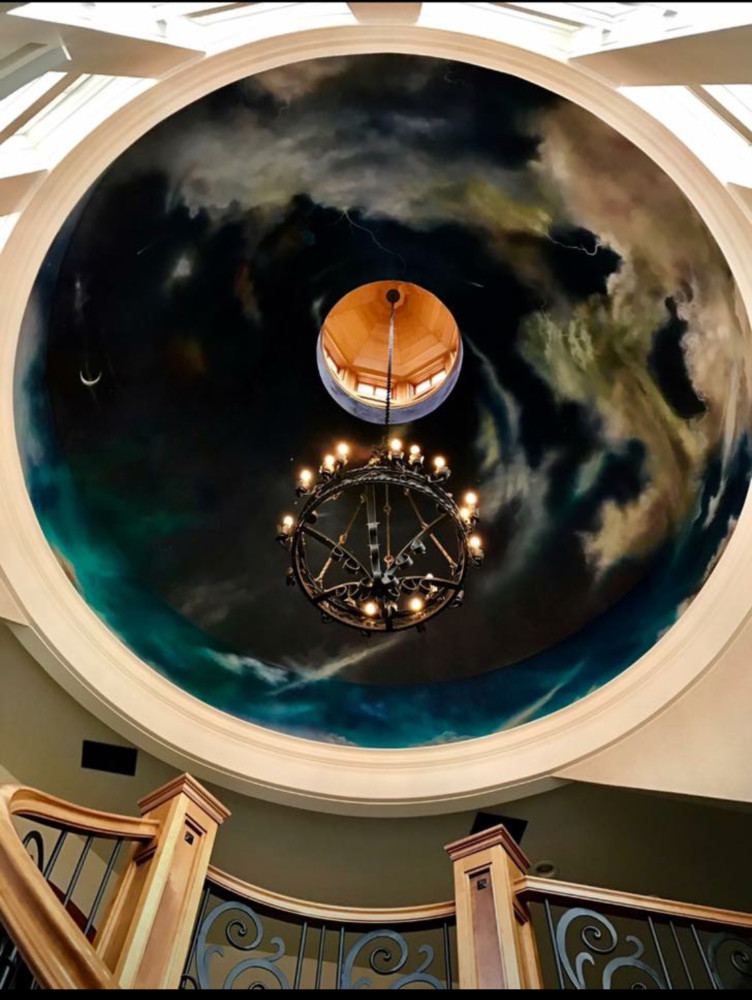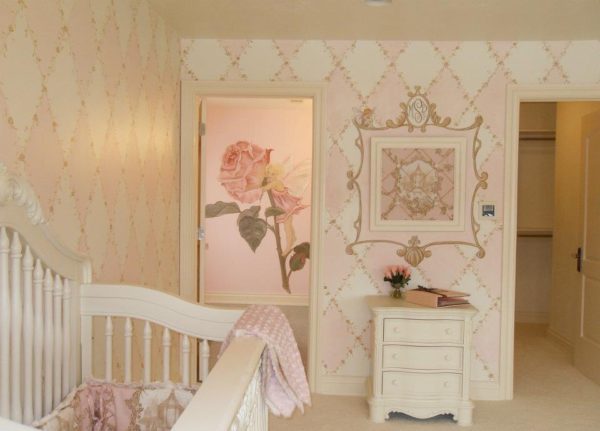Interior Mural Inspiration
Customize your space with a statement-making wall mural
Paul Schroeder, owner of Schroeder Carpentry Inc. of Greenville, not only works with muralists in his business, but he is also the proud owner of a mural in his own home. The mural depicts the farm Schroeder lived on as a child in Greenville and features a barn, shed and silos.
“When we had put an addition on our house, we had this 24-foot wall in the kitchen/dining room with no idea how to decorate it,” Schroeder says. “I met a mural artist on a job site one day and asked her to take a look at it. When facing the wall, it is as if you are facing the family farm I grew up on which is no longer there.”
Before getting an office space of his own, Schroeder held client meetings at his home with the mural as a backdrop. He believes that it inspired customers to get murals of their own.
From bold geometric patterns to oversized floral designs, homeowners are putting a personal stamp on their spaces with statement-making murals. Hand painted murals can turn an average wall into a one-of-a-kind work of art.
A Personal Touch
“People want something different and unique for their home that nobody else has, that is personal to them and their style,” says Sharon Kuplack, muralist and owner of Whimsical Walls in Neenah.
Peter Koury, a De Pere muralist whose work has appeared in the homes of celebrities including heavy-metal musician Rob Zombie, says one of the benefits of a custom mural is the character and personality it brings to a home. Koury created a one-of-a-kind cosmic mural for homeowner Dennis Garitty of Green Bay.
 Eleven years ago, Garitty built a home with many special features including an elaborate circular staircase that traverses three stories. The staircase, situated in a turret, has its own roof with a vaulted ceiling and a cupola on top surrounded by glass. Garitty thought that the ceiling was crying out for something special.
Eleven years ago, Garitty built a home with many special features including an elaborate circular staircase that traverses three stories. The staircase, situated in a turret, has its own roof with a vaulted ceiling and a cupola on top surrounded by glass. Garitty thought that the ceiling was crying out for something special.
Garitty worked with Koury to come up with the perfect art for his unique ceiling. The mural they designed includes planets, stars, meteorites and sunsets. “It’s a little busy, but it worked perfectly,” Garitty says. “As you look up the center of the staircase, you’re looking up to the heavens.”
Finding An Artist
As was the case with Garitty’s mural, Schroeder says murals usually aren’t included in a home’s original plan. Rather, he works with customers on murals as they work through the building process. Once a project is getting to the finishing stages, and a room, or wall, or niche could use a little extra something, Schroeder mentions it may be a prime spot for a mural. Then, he suggests a muralist. When selecting a muralist, it’s important for homeowners to do their homework.
“Search out the people who have done them and go check them out,” Schroeder says. “It can be a lot of money and a long process, so you should do your research to know what you’re getting. Find someone that does them and does them well.”
Kuplack encourages homeowners to look at a muralist’s portfolio to ensure that their style is compatible with your own. It can also be helpful for the muralist to make a site visit ahead of time to discuss budget.
“Have them come out and look at the place first and give a price on what it would cost,” Kuplack says. “Don’t let it be open-ended and have a cap on how much it’s going to cost.”
Working with an experienced muralist can save you time and money. Koury recommends that homeowners search online to see artists and their work, or even call local galleries for artist recommendations.
“To avoid mistakes, look into the artist who wants to do the job and make sure they have the experience to do a good job on the project,” Koury says.
Time, Space and Theme
Completing a mural takes proper planning and thoughtful scheduling. Depending on the complexity and size of a project, Kuplack has spent anywhere from 2 to 22 hours completing a mural and Koury has spent 1 day to 3 weeks, so make sure to allow enough time for the mural to be completed properly.
While Schroeder’s mural encompasses a 24-foot wall in his home, that much space isn’t always required – smaller homes can still accommodate a mural. Interior designer Carol Smits, owner of Designs of the Times in Combined Locks, says murals can actually add depth and a lifted look to ceilings. Certain types of murals, like decorative hand painted scrolls and floral pieces, work well in small spaces.
Smits explains that having a consultation is the first step to the mural creation process. During that time, she gets an understanding of the client’s likes, dislikes, functional needs, privacy requirements and color preferences.
“Most people want to try something different than just a solid wall, something more artistic, whether it be a children’s scene, nature scene or sports scene,” she says.
Smits says it’s important to consider a home’s existing architectural features and style when incorporating a mural. Modern or contemporary art styles may not fit in a historical or traditional home. Modern homes may better accommodate a contemporary mural.
 Kuplack primarily paints murals in children’s rooms, but has also done bathrooms, kitchens and odd nooks and crannies. Popular mural themes include sports themes for boys’ rooms, floral and fairy themes for girls’ rooms and modern eclectic murals. She has also painted atmospheric landscapes of Italy and China and used glow-in-the-dark paint and three-dimensional items that give murals more life. Quotes and meaningful phrases are other popular options.
Kuplack primarily paints murals in children’s rooms, but has also done bathrooms, kitchens and odd nooks and crannies. Popular mural themes include sports themes for boys’ rooms, floral and fairy themes for girls’ rooms and modern eclectic murals. She has also painted atmospheric landscapes of Italy and China and used glow-in-the-dark paint and three-dimensional items that give murals more life. Quotes and meaningful phrases are other popular options.
Kuplack’s creative process includes taking existing decor, including the furniture and the style of art, into account and making it flow with the mural design. Kuplack likes to tie murals into a space by repeating colors and designs found throughout the room’s decor. “I can take elements from bedding or furniture or other personal items and combine them all into the design,” she says.
A Lasting Gallery Wall
Finding the right marriage of placement and theme for your mural is important, Smits says. For example, a sports-themed mural may not be great for a main floor office. Instead, Smits would recommend a lower level bar or rec room as a more natural fit.
When considering a mural for your home, sometimes less is more. Ideas can get busy and overworked so keep it simple and contained to one location. “When getting a mural done, don’t overdo it,” Kuplack says. “Some people can get so excited and want to overdo things.”
Because murals tend to be show-stealers, homeowners may want to keep the room’s decor understated as to not overwhelm the senses or focus on colors that are complementary to the mural’s palette.
While planning and creating a home mural can be a lengthy and involved process, Kuplack says the benefits a mural offers make it all worth it.
“When you get done and can stand back and look at it with everything in the room is very exciting,” she says. “I love the whole process, but it is always very fulfilling to see the end result.”
The satisfaction from a finished mural that will stand the test of time is felt by both artist and client.
“I feel pretty good and have a sense of accomplishment,” Koury says. “My happiness is having them walk in and see the final result.”










Leave a Comment